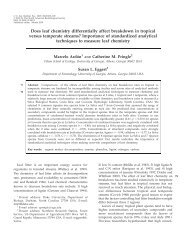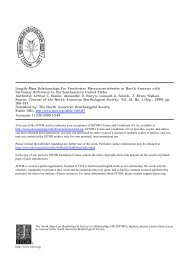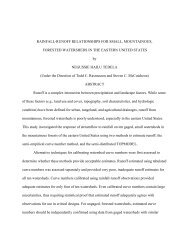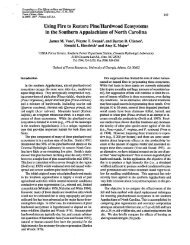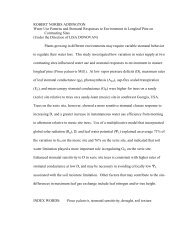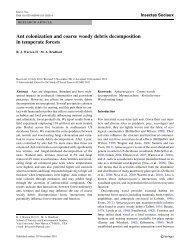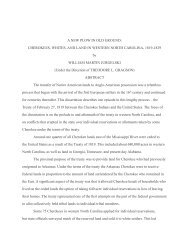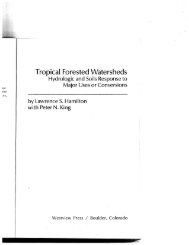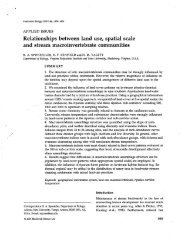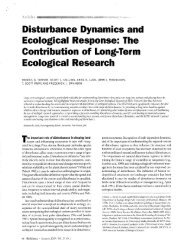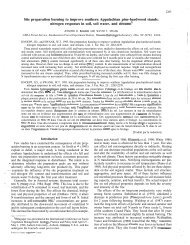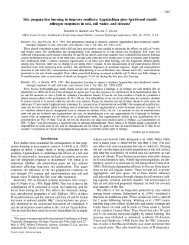biology join - Coweeta LTER - University of Georgia
biology join - Coweeta LTER - University of Georgia
biology join - Coweeta LTER - University of Georgia
Create successful ePaper yourself
Turn your PDF publications into a flip-book with our unique Google optimized e-Paper software.
Articles<br />
(Wiek et al. 2006, Withycombe and Wiek 2011). In the study,<br />
the knowledge, preferences, and values <strong>of</strong> a broad range <strong>of</strong><br />
experts and regional stakeholders were elicited, deliberated,<br />
and integrated. The core stakeholder-engagement activities<br />
were 15 meetings in all parts <strong>of</strong> the city, designed to elicit<br />
vision statements, and a visioning workshop, in which the<br />
elicited vision statements were revisited, systemically linked,<br />
and reprioritized on the basis <strong>of</strong> potential conflicts. More<br />
than 100 citizens, city planners, business representatives,<br />
nonpr<strong>of</strong>it organization members, and researchers participated<br />
in this workshop. The vision and the scenarios are now<br />
being used by the city administration in planning, training,<br />
and fund raising, as well as for teaching purposes in public<br />
schools and at Arizona State <strong>University</strong>. Overall, the project<br />
spurred a rich public discussion about the future directions<br />
in which Phoenix may be headed and about the degree to<br />
which these directions align with a desirable and sustainable<br />
future vision. The substance <strong>of</strong> the vision and scenarios has<br />
been incorporated into the current public-hearing draft <strong>of</strong><br />
the city’s general plan (City <strong>of</strong> Phoenix 2010), which is the<br />
city’s most important guide for long-term planning and<br />
development. It provides direction for planning and allows<br />
researchers, policy analysts, and stakeholders to evaluate the<br />
effectiveness <strong>of</strong> policies and actions.<br />
The Scenarios Network for Alaska Planning: The Bonanza Creek<br />
<strong>LTER</strong> site. Arctic and boreal forests are warming about twice<br />
as fast as the global average, creating widespread concern and<br />
interest in the patterns and consequences <strong>of</strong> climate change,<br />
especially among northern residents. At the Bonanza Creek<br />
(BNZ) <strong>LTER</strong> site, scenarios have been used as both a research<br />
and a communications tool to explore the consequences <strong>of</strong><br />
recent and projected climate change in Alaska. Rapid change<br />
experienced in Alaska has focused public attention on these<br />
scenarios, which in turn has led to the establishment <strong>of</strong><br />
a research partnership: the Scenarios Network for Alaska<br />
Planning (SNAP; www.snap.uaf.edu), which comprises the<br />
BNZ, the <strong>University</strong> <strong>of</strong> Alaska, and several state and federal<br />
agencies, local communities, and nonpr<strong>of</strong>its. SNAP has<br />
developed scenarios <strong>of</strong> future climate as high-resolution<br />
maps <strong>of</strong> mean monthly historical and projected temperature<br />
and precipitation (between 1900 and 2100) that account for<br />
the known effects <strong>of</strong> topography and the movement <strong>of</strong> air<br />
masses. By downscaling the five global circulation models<br />
that were shown to perform best in the far north and by providing<br />
outputs for three emission scenarios defined by the<br />
IPCC, SNAP <strong>of</strong>fers stakeholders a range <strong>of</strong> possible climate<br />
futures, rather than a single prediction. Moreover, discussion<br />
and interpretation <strong>of</strong> uncertainty play a large role in SNAP<br />
projects. The actual technical work <strong>of</strong> downscaling the<br />
climate scenarios is an expert-driven process. However, all<br />
SNAP projects are collaborations between SNAP researchers<br />
and land managers or other stakeholders. These stakeholders<br />
help determine how the data will be linked to landscape<br />
models, existing data sets, and local knowledge and<br />
how the resulting scenarios will be used and interpreted.<br />
For example, in collaboration with US Fish and Wildlife<br />
Service, The Nature Conservancy, and other partners, SNAP<br />
researchers have used climate-change scenarios to model<br />
potential biome shifts and changes in the ranges <strong>of</strong> endemic<br />
and invasive species. In the resulting report (Murphy et al.<br />
2010), barren-ground caribou, Alaska marmots, trumpeter<br />
swans, and reed canary grass were used as indicator species<br />
to assess multiple possible futures, given the possible range<br />
<strong>of</strong> climate-change impacts. In addition, the climate scenarios<br />
have been used directly by Alaska communities in order to<br />
inform decisionmaking about the future sustainability <strong>of</strong><br />
hydroelectric generation and other energy project plans<br />
(Cherry et al. 2010).<br />
The American Forest Futures Projects: The Harvard Forest,<br />
Andrews Forest, Bonanza Creek, <strong>Coweeta</strong>, and North Temperate<br />
Lakes <strong>LTER</strong> sites. Scenario planning is the focus <strong>of</strong> American<br />
Forest Futures Projects, an emerging group <strong>of</strong> cross-site<br />
<strong>LTER</strong> projects that are being advanced across the major<br />
forested regions <strong>of</strong> the United States in collaboration with<br />
major NSF-sponsored programs (including, e.g., five <strong>LTER</strong><br />
Network sites, NEON, ULTRA), the US Forest Service, the<br />
US Geological Survey, the Smithsonian Institution, and<br />
several NGOs (e.g., The Nature Conservancy, the Ecological<br />
Society <strong>of</strong> America, the Heinz Center). The projects were<br />
designed to address pressing scientific questions related to<br />
how and why forested regions vary in their socioecological<br />
responses to global change (www.wildlandsandwoodlands.<br />
org/node/133). In a parallel thrust, the researchers designed<br />
the projects as a means to advance several burgeoning<br />
network-level <strong>LTER</strong> Network priorities, such as national-<br />
and regional-scale stakeholder engagement, development<br />
<strong>of</strong> models and visualization tools, and communication with<br />
policymakers. The projects rely on tiered scenarios developed<br />
at national and regional scales to address at least four<br />
dominant themes: economic development, energy exploitation<br />
(e.g., bioenergy), climate mitigation and adaptation,<br />
and landscape-scale conservation.<br />
The researchers have convened a national advisory board<br />
<strong>of</strong> experts, consisting <strong>of</strong> federal agency and national NGO<br />
representatives, to develop national-scale scenarios describing<br />
the anticipated drivers and the changes associated with<br />
each <strong>of</strong> the themes. After they are finalized, the suite <strong>of</strong><br />
national-scale scenarios will be reinterpreted at regional<br />
scales around the country by engaging regional stakeholders<br />
(e.g., natural-resource managers, scientists, agency <strong>of</strong>ficials,<br />
conservation pr<strong>of</strong>essionals) in the development <strong>of</strong> narratives<br />
in which the local manifestation <strong>of</strong> each <strong>of</strong> the national<br />
scenarios is described. This process <strong>of</strong> downscaling global<br />
scenarios to local scales can be an effective approach for<br />
participatory capacity building and for motivating behavioral<br />
changes in local stakeholders and decisionmakers (Shaw<br />
et al. 2009). The regional scenarios will, in turn, be used to<br />
define land-use assumptions and to parameterize spatially<br />
interactive landscape-simulation models (e.g., Thompson<br />
et al. 2011) within study a series <strong>of</strong> study landscapes<br />
372 BioScience • April 2012 / Vol. 62 No. 4 www.biosciencemag.org



